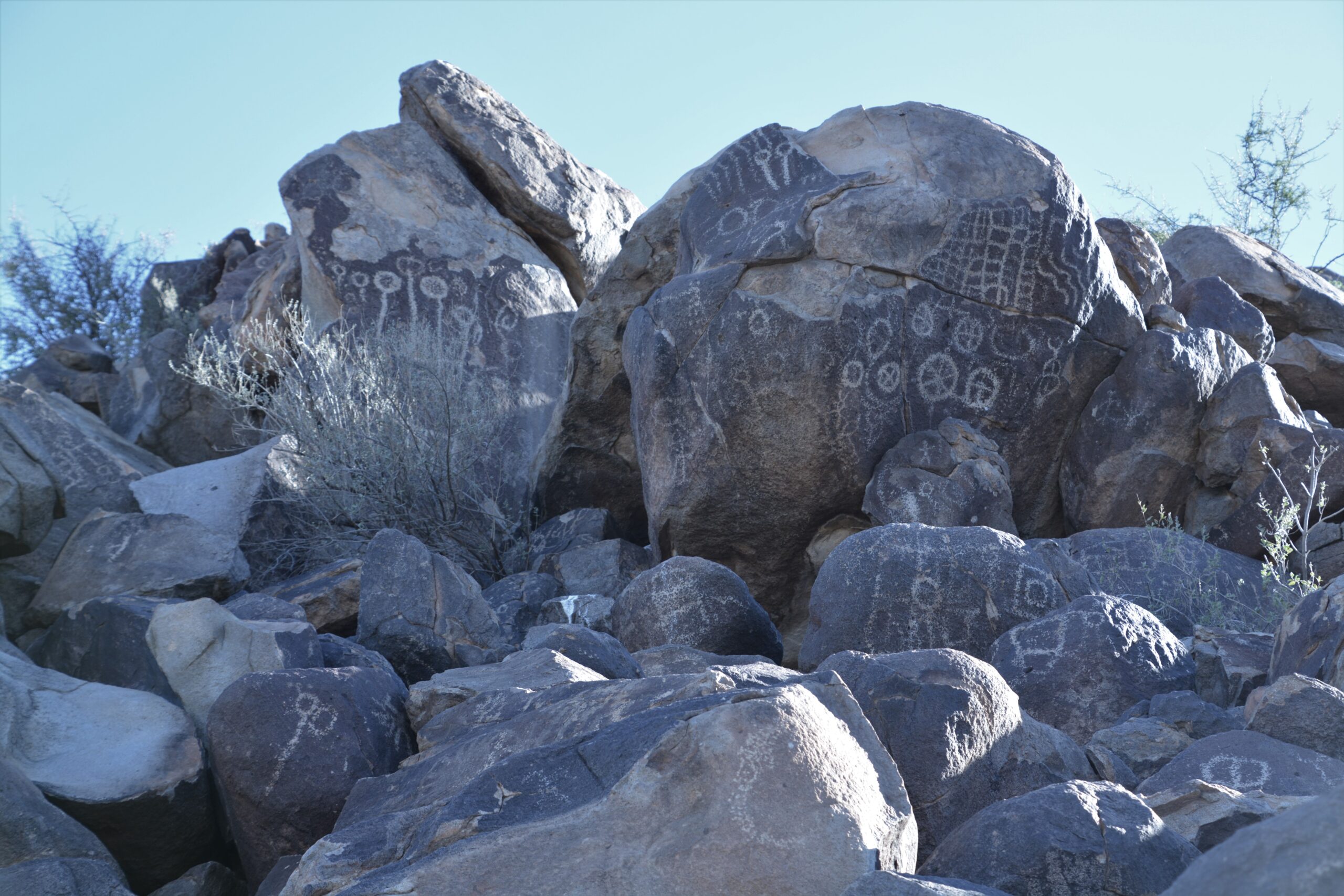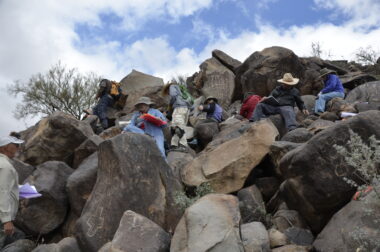
- This event has passed.
Janine Hernbrode – “Bell Rocks and Megaphones: discoveries of sounds coupled with petroglyphs in Ancestral O’odham (Hohokam) ritual landscapes”
November 20, 2023 @ 7:00 pm - 8:30 pm MST

One of the three megaphone acoustic sites originates in this complex at Cocoraque Ranch. Words spoken in a normal tone of voice can be heard easily 115 meters away. Photo by Lance Trask.
Lectures are offered in a hybrid format, presented in-person at the University of Arizona in Tucson, Building ENR2, Agnese Nelms Haury Lecture Hall, Room 107, and simultaneously through Zoom.
Join in Person or Join by Zoom
To register for the Zoom presentation, click the button below:
|
|
Distributed amidst the petroglyphs at three of the largest Ancestral O’odham (Hohokam) petroglyph sites in Southern Arizona are assemblages of boulders that resonate when struck producing distinct bell-like sounds. The visual traces of sound-making on large bell rocks and adjacent bedrock indicate they were not only chimed with percussion strikers to resonate with sound but were also abraded with a grinding motion to produce sound volumes. Some of the bell rocks investigated also appear to have been roughly shaped or pecked to resemble animal heads, an indication of the boulders being an object accorded animacy and of having “voice.” Many of these boulders have petroglyphs and use-wear evidence consistent with usage during pre-contact times. Recent investigation of remote smaller petroglyph sites that lack naturally occurring bell rocks, has revealed the presence of both bell rock manuports and a ringing striker. A fourth large petroglyph site lacks bell rocks but is associated with a cache of copper bells on a hillside overlooking the site. These discoveries further illuminate the importance of bell-like sounds in the cultural practice of the Hohokam and suggest that the bells were necessary to complete the landscape characteristics of sacred sites. Experiments show abrading makes volumes of sound. This work introduces the concept of high-volume sound generation as part of Hohokam ritual activities. The ethnographic record for the Tohono O’odham reveals that the sounds of bells and the production of volumes of sound are both used in their rituals.
The program also includes a previously unknown co-occurrence of specific Ancestral O’odham (Hohokam) imagery and landscape features that produce a megaphone-like effect at three petroglyph sites near Tucson. At the sources of the megaphones, each site has imagery of barbells (two circles connected by a line), elaborated barbells, anthropomorphs in barbell form, and anthropomorphs with either arms or legs bowed reminiscent of their barbell origins. These images on boulders or in caves are coupled with cracks, holes, or edges that suggest passageways from the Present World to the Lower World, or vice versa. The route seems to enable human emergence consistent with the ethnography for the Tohono O’odham. The sites all enhance more voice projection than would normally be expected, utilizing the shape of the landscape to produce the megaphone-like acoustic effect.
Speaker Janine Hernbrode has spent a lifetime in an avocational pursuit of observing, recording, and researching rock art. Since her retirement from her “real” job returned her to Tucson in 2004 she participated in AAHS’s Tumamoc recording project, and then headed up efforts to record an additional 71 petroglyph sites in Southern Arizona. She is leader of the “Rock Band” a volunteer rock art recording group which today consists of 15 people including 3 archaeologists, 4 photographers, a biologist, a musician, a researcher, and 5 other petroglyph recorders. The recordings include detailed drawings, measurements, location data, biological data and photographs. The largest site, the Cocoraque Complex, includes both the public BLM site and the private Cocoraque Ranch both sponsored by AAHS. This work has been honored by the Arizona State Historic Preservation Office and nationally by both the Society for American Archaeology, and the American Rock Art Research Association. Wary of becoming a relentless quantifier, she uses the data generated by the Rock Band and ethnographic studies to find hints of meaning and ties to ancient cosmology in the rock art imagery. Ms. Hernbrode is a graduate of the University of Arizona.
Members of the Rock Band recording Cocoraque Ranch in 2017: left to right, Carl Evertsbusch, Gordon Hanson, Mary Andersen, Lance Trask, Fran Maiuri, guest Gayle Hartmann, Bill Gillespie, Janine Hernbrode. Photo by Lee White.
Suggested readings:
For information on the basics of Archaeoacoustics:
Diaz-Andreu, Margarita, and Tommaso Mattioli
2015 Archaeoacoustics or Rock Art: Quantitative Approaches to the Acoustics and Soundscape of Rock Art. In Proceedings of the 43rd Annual Conference on Computer Applications and Quantitative Methods in Archaeology, edited by Stefano Campana, Roberto Scopigno, Gabriella Carpentiero and Marianna Cirillo, pp. 1049-1058. Universita di Siena, Siena, Italy.
For background on the Hohokam religion:
Bostwick, Todd W., Stephanie M. Whittlesey, and Douglas R. Mitchell
2010 Reconstructing the Sacred in Hohokam Archaeology: Cosmology, Mythology, and Ritual. Journal of Arizona Archaeology 1:89–101.
Wright, Aaron
2014 Ritualization of Hohokam Rock Art in Religion on the Rocks: Hohokam Rock Art, Ritual Practice, and Social Transformation. University of Utah Press, Salt Lake City, pp.136-187.
For background on petroglyphs and bell rocks:
Hernbrode, Janine
2022 Rings and Roars: Voices of Bell Rocks in Ancestral O’odham (Hohokam) Ritual in American Indian Rock Art, Vol. 48. Electronic document, www.academia.edu/107387166/Rings_and_Roars
Hernbrode, Janine and Peter Boyle
2016 Petroglyphs and Bell Rocks at Cocoraque Butte: Further Evidence of the Flower World Belief Among the Hohokam. In American Indian Rock Art, Volume 42, edited by Ken Hedges pp. 91–105. American Rock Art Research Association, San Jose, California. Electronic document, www.academia.edu/35989176/Petroglyphs_and_Bell_Rocks
2018 Becoming Human: Rock Art Depictions of Transformation in Landscapes of Emergence in American Indian Rock Art, Vol. 44. David A. Kaiser and James D. Keyser, editors. American Rock Art Research Association, pp. 97-110. Electronic Document, www.academia.edu/40533619/Becoming_Human_Hernbrode_Boyle
 All Events
All Events
